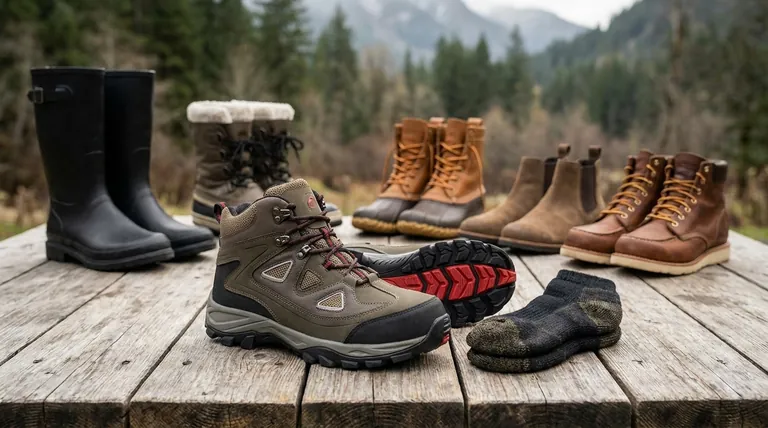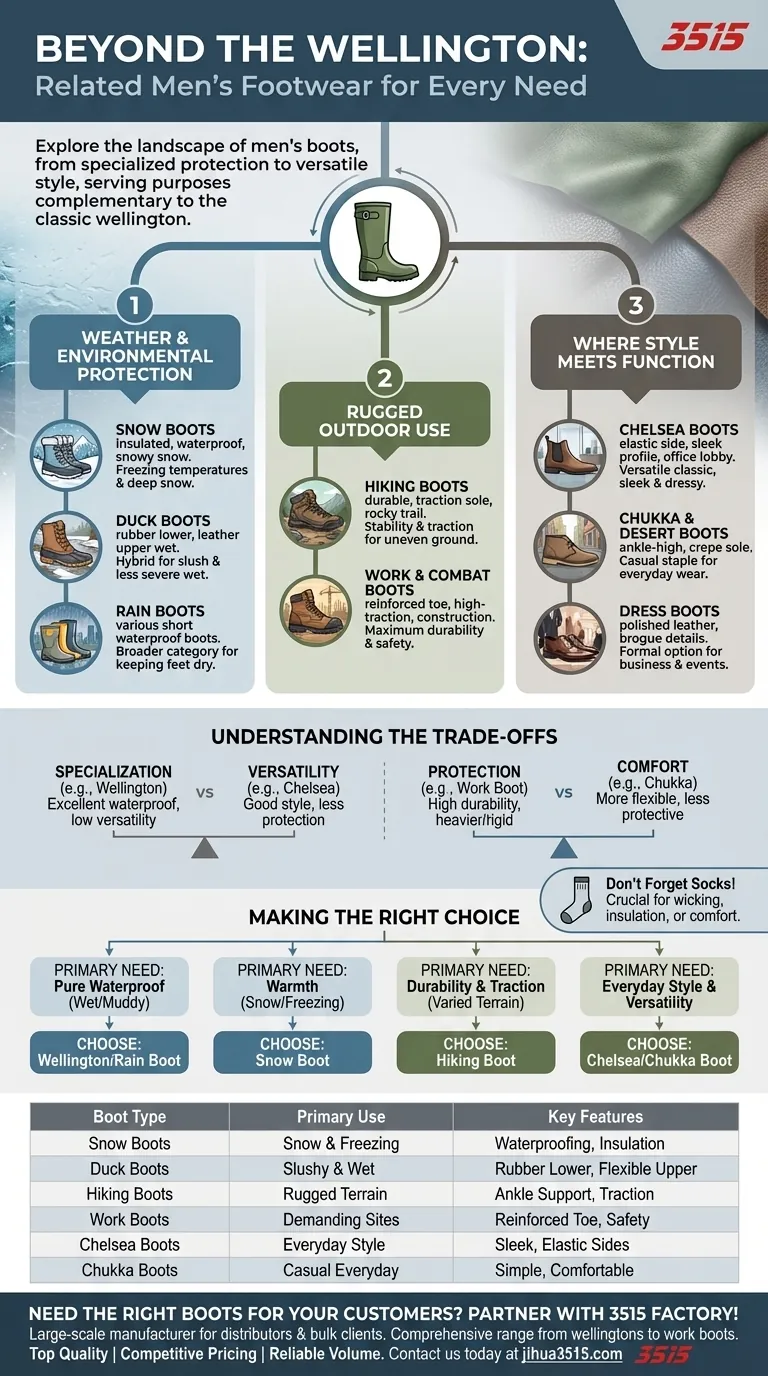Beyond the classic wellington, a range of men's footwear serves similar or complementary purposes, from specialized boots for snow and rugged terrain to more stylish options for casual wear. The most directly related footwear includes other waterproof boots like snow boots and duck boots, while hiking boots offer durability for different outdoor activities.
While wellington boots offer unmatched waterproof protection, related footwear provides alternatives that trade some of that specialization for enhanced features like insulation for extreme cold, traction for rugged terrain, or greater style and versatility for everyday use.

Boots for Weather and Environmental Protection
Wellington boots are masters of a specific domain: wet, muddy conditions. Other boots offer specialized protection for different, often more extreme, environments.
The Direct Alternative: Snow Boots
Snow boots are the closest functional relatives to wellingtons. They are designed for cold and snowy weather, offering both waterproofing and crucial insulation that wellingtons typically lack.
The Hybrid Solution: Duck Boots
Duck boots combine a waterproof rubber lower section, similar to a wellington, with a more flexible leather or canvas upper. This makes them a popular choice for slushy, less severe wet conditions where some flexibility is desired.
The Broader Category: Rain Boots
"Rain boot" is often used interchangeably with "wellington." However, it can encompass a wider variety of waterproof boots that may be shorter, lighter, or made from different materials, all sharing the core purpose of keeping feet dry.
Boots for Rugged Outdoor Use
This category shares the wellington's emphasis on durability and protection but applies it to challenging terrain rather than just wetness.
For Trail and Terrain: Hiking Boots
Hiking boots are engineered for stability and traction on uneven ground. They prioritize ankle support and durable soles, making them the standard for any serious outdoor trek where mud is only one of many potential challenges.
For Demanding Work: Work & Combat Boots
Boots like work boots, logger boots, and combat boots are built for maximum durability and safety in high-risk environments. They often feature reinforced toes and high-traction soles, designed to protect the wearer on a job site or in tactical situations.
Boots Where Style Meets Function
While wellingtons are purely functional, many popular men's boots borrow the ankle-high form factor but prioritize aesthetics and versatility for daily wear.
The Versatile Classic: Chelsea Boots
Known for their elastic side panels, Chelsea boots are a famously versatile option. They can be dressed up or down, offering a sleek profile that wellingtons lack.
The Casual Staple: Chukka & Desert Boots
Chukka boots are simple, ankle-high boots with two or three eyelets for laces. The desert boot, a specific type of chukka with a crepe sole, offers a more casual, comfortable feel for everyday situations.
The Formal Option: Dress Boots
Dress boots, such as Balmoral or Brogue boots, are the most formal in this category. They essentially extend a formal dress shoe into a boot format, providing a polished look suitable for business or formal events.
Understanding the Trade-offs
Choosing the right boot means understanding what you gain and what you give up with each option.
Specialization vs. Versatility
A wellington boot is highly specialized. It provides excellent, seamless waterproof protection but offers very little breathability, insulation, or stylistic versatility. Other boots compromise on this absolute waterproofness to gain other advantages.
Protection vs. Comfort
Heavy-duty work boots provide immense physical protection but can be heavy and rigid. Lighter boots like chukkas offer far more comfort and flexibility but provide minimal protection against weather or workplace hazards.
The Importance of Socks
Across all categories, the right socks are crucial. A good pair of socks complements the boot's function, whether it's wicking moisture in a hiking boot, providing insulation in a snow boot, or simply ensuring comfort in a casual shoe.
Making the Right Choice for Your Goal
Your primary need should dictate your choice of footwear.
- If your primary focus is pure waterproof protection for wet, muddy conditions: The classic wellington or a similar rain boot remains the undisputed best choice.
- If your primary focus is warmth in snow and freezing temperatures: A dedicated, insulated snow boot is the only appropriate option.
- If your primary focus is durability and traction for varied terrain: A quality hiking boot provides the necessary support and grip.
- If your primary focus is everyday style and versatility: A Chelsea or chukka boot offers a sharp look suitable for a wide range of casual or smart-casual settings.
Ultimately, understanding the landscape of men's boots allows you to select the right tool for the job, ensuring your feet are protected, comfortable, and appropriately styled for any situation.
Summary Table:
| Boot Type | Primary Use | Key Features |
|---|---|---|
| Snow Boots | Snow & Freezing Temperatures | Waterproofing, Insulation |
| Duck Boots | Slushy & Wet Conditions | Rubber Lower, Flexible Upper |
| Hiking Boots | Rugged Terrain & Trails | Ankle Support, Traction, Durability |
| Work Boots | Demanding Job Sites | Reinforced Toe, Safety Features |
| Chelsea Boots | Everyday Style & Versatility | Sleek Profile, Elastic Sides |
| Chukka Boots | Casual Everyday Wear | Simple Design, Comfortable |
Need the Right Boots for Your Customers? Partner with 3515 Factory!
As a large-scale manufacturer, 3515 produces a comprehensive range of footwear for distributors, brand owners, and bulk clients. Our production capabilities encompass all types of boots—from durable wellingtons and snow boots to stylish Chelsea and work boots—ensuring top quality, competitive pricing, and reliable volume.
Contact us today to discuss your specific needs and let us help you equip your market with the perfect footwear solutions.
Visual Guide

Related Products
- Safety Footwear Wholesale Manufacturer for Custom OEM/ODM Production
- Factory Direct Wholesale Rain Boots Durable Waterproof & Fully Customizable
- Factory-Direct Wholesale Canvas Boots with High-Traction Rubber Soles
- Wholesale Waterproof Tactical Boots Custom Suede & High-Traction Soles
- Wholesale Safety Footwear Manufacturer for Bulk & Custom OEM Orders
People Also Ask
- What are the differences between steel toe, composite toe, and alloy toe Wellington boots? Choose the Right Safety Toe for Your Job
- What are the cultural perspectives on wearing shoes in the house? A Guide to Home Etiquette & Hygiene
- Is it normal to wear shoes in the house? A Guide to Hygiene, Comfort & Culture
- Is safety-toe as good as steel toe? Choose the Right Protection for Your Job
- How long can you wear safety boots? The Lifespan is Determined by Wear, Not Time



















